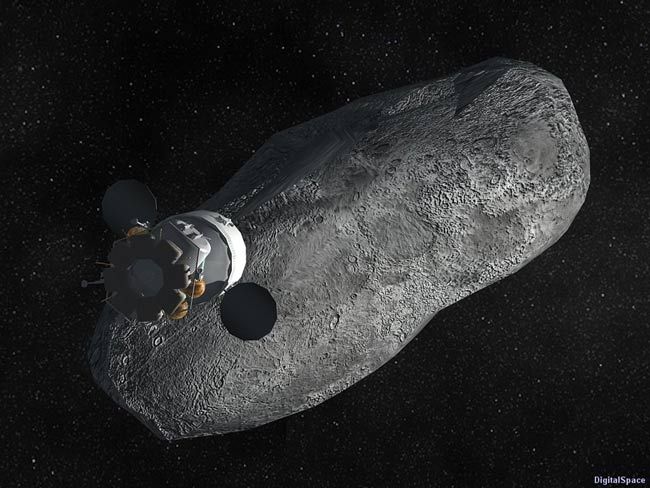I had not thought of this. The new NASA vehicle could be used to send Astronauts to explore near-Earth objects: potentially threatening asteroids, meteors and comets. In fact they say they studied the possibility of doing this when the ship was designed. This a is pretty cool idea!
Announcement
Collapse
No announcement yet.
New NASA craft considered for Deep Space flights
Collapse
X
-
-
Okayyyyy.
I know this is going to be a hard sell because most people don't see any value in the Space Program. NASA has never possessed nor designed a deep space vehicle. If they use this spacecraft to travel to Near Earth asteroids valuable information can be gathered about the composition of these deadly rocks. That in turn would lead to strategies on how to divert them should they be on a collision course with Earth.
Most people sem to have forgotten about the Great Comet Crash where in the early 1990's 19 or more cometary fragments crashed into Jupiter. If even one of these had hit Earth we'd all be a memory. No more us, no more Megos.Last edited by johnmiic; Aug 2, '07, 9:23 AM.Comment
-
Those comet fragments had been orbiting Jupiter for a couple years before they impacted. That's why gas (and gravity) giant Jupiter is known as the "cosmic vacuum cleaner" for the inner solar system.. it frequently captures solar and free-floating debris into its orbit. Asteroid and comet fragment impacts on Jupiter are common, at least by astronomical standards. The chances of a comet or fragments striking earth are tiny in comparison.Comment
-
I beg to differ. Scientists are very worried about astreroid impact. There are 2 they know of that will come close in the next 100-150 yrs that could get close enough to wipe us out. Those are only 2 they know of.Comment
-
I didn't say that I don't see any value in the space program. A lot of practical innovations have come indirectly out of space research, but the direct result of spending billions of dollars to put men on the moon has been negligible; we know a little bit more about how the moon was formed, and the processes involved. Big whoop. If there's a comet or an asteroid out there with our name on it, no amount of Chicken Little paranoia is going to help us. It's going to be one hell of a spectacular show when it hits, so you might as well sit back and enjoy it because there's nothing anyone can do to stop it.Okayyyyy.
I know this is going to be a hard sell because most people don't see any value in the Space Program. NASA has never possessed nor designed a deep space vehicle. If they use this spacecraft to travel to Near Earth asteroids valuable information can be gathered about the composition of these deadly rocks. That in turn would lead to strategies on how to divert them should they be on a collision course with Earth.
Most people sem to have forgotten about the Great Comet Crash where in the early 1990's 19 or more cometary fragments crashed into Jupiter. If even one of these had hit Earth we'd all be a memory. No more us, no more Megos.
Comment
-
I didn't say that I don't see any value in the space program. A lot of practical innovations have come indirectly out of space research, but the direct result of spending billions of dollars to put men on the moon has been negligible; we know a little bit more about how the moon was formed, and the processes involved. Big whoop. If there's a comet or an asteroid out there with our name on it, no amount of Chicken Little paranoia is going to help us. It's going to be one hell of a spectacular show when it hits, so you might as well sit back and enjoy it because there's nothing anyone can do to stop it.
The tempurpedic air mattress has sure been worth the billions spent and has helped countless backs.
All kidding aside, the Space Shuttle program has been nothing short of incredible even with the couple of disasters. I do wish they would plan another lunar landing (it seems unbelievable that man hasn't stepped on the moon since the 1960's)!
As far as asteroids, I tend to agree that I don't think there is anything that can be done. I don't know a whole lot about the physics aspect of it but I think an asteroid impact that is just a couple of miles in diameter could do unthinkable damage and I don't think it is something that can be detected unless a highly sophisticated system is placed up in space."The farther we go, the more the ultimate explanation recedes from us, and all we have left is faith."
~Vaclav HlavatyComment
-
Geez, everybody knows that in the event of an impending asteroid impact a shuttlecraft will be launched. Once it has successfully landed on the 'roid, a few nuclear charges will be placed to be detonated once the shuttlecraft is safe and clear. When the crew of three men and one woman return to Earth, they will develop strange powers that will allow them to do even more good for mankind.The tempurpedic air mattress has sure been worth the billions spent and has helped countless backs.
All kidding aside, the Space Shuttle program has been nothing short of incredible even with the couple of disasters. I do wish they would plan another lunar landing (it seems unbelievable that man hasn't stepped on the moon since the 1960's)!
As far as asteroids, I tend to agree that I don't think there is anything that can be done. I don't know a whole lot about the physics aspect of it but I think an asteroid impact that is just a couple of miles in diameter could do unthinkable damage and I don't think it is something that can be detected unless a highly sophisticated system is placed up in space.
Duh.Comment
-
From what I've read and seen on The Science Channel current theories about diverting asteroids via explosions are:
Solid, iron-type asteroids could be deflected by an explosive device detonated nearby the object. Speculation is you need only nudge it a degree to avert disaster.
Porous asteroids, low weight, would not be affected by nearby blasts. They would probably absorb it.
Blasting the asteroid itself into tiny pieces is inadvisable because most of the mass will not change course. So instead of 1 big asteroid you have hundreds of little killers headed for Earth.
Sucess in diverting these rocks depends on early enough warning; perhaps a year or 2, and the composition of the rock.
another idea proposed:
Mass Driver - With enough lead time mine the asteroid and send the minerals to the Moon or back to Earth as raw materials. Basically eat up the asteroid till it poses no threat.Comment
-
Again, I might be wrong but an asteroid maybe a few miles in diameter which would go undetected with searching devices hitting the Earth would create mass destruction."The farther we go, the more the ultimate explanation recedes from us, and all we have left is faith."
~Vaclav HlavatyComment




Comment